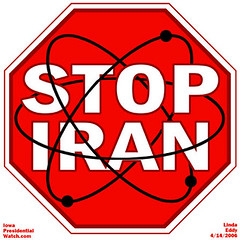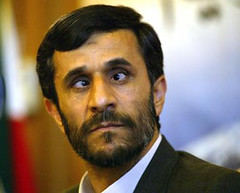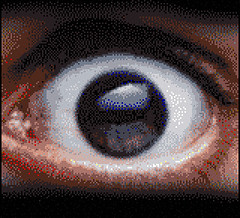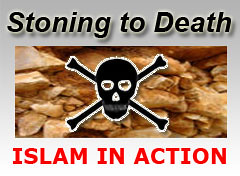Tuesday, July 21, 2009
Middle East ATOMIC CONFLICT WOULD KILL TENS OF MILLIONS
Most strategists agree there are three obvious targets that will have to be destroyed to damage Iran's nuclear program -- including the uranium conversion facility near Isfahan.
War would contaminate entire region.
Alan Note: PENNY WISE, DOLLAR FOOLISH mindsets of the Obama Administration, which threw the Iranian student protestors and a possible regime change, under the bus and encouraged the Mullah brutal represssions, invites an Israeli attack on Iran and possibly an American-Isaeli coalition attack when alternative options disappear.
In the light of the enormous potential death toll in the article on this page, the alternative of attacking Islamic Iran - and the comparatively "low" death toll of the Iranian populace, including innocent civilians, becomes forcibly "acceptable".
Remember the tens of millions being killed in the alternative of not attackinga nd destroying, ALSO includes millions and millions of innocent civilians of the region, not just Iranians.
Obama is choosing to prevent and impede, at any cost, an amputation of a gangrenous limb (Islamic Iran) and lose the whole body which then dies.
PRAGMATIC,THOUGH CRUEL, REALITY FOR SOLVING ISLAMIC IRAN click here
The USA has over 5,000 targets lined up with GPS co-ordinates inside Iran so an instant "disarming by bombing" of the militants. Revolutionary Guards (IRGC), Bassiji, Qods and other paramlitary and suppression enforcement forces, strange as it may sound, could in the aggregate, actually SAVE lives.
By Peter Goodspeed
It's the nightmare that haunts the modern Middle East --Iran succeeds in its quest for nuclear weapons and goes to war with Israel, causing massive human casualties and destruction on a demonic scale that in turn could trigger a worldwide economic collapse.
Now, researchers at Washington's Center for Strategic & International Studies have tried to assess the extent to which civilian targets will be damaged in any Iran-Israel nuclear exchange.
The initial fireball accompanying a 100-kiloton nuclear bomb exploding in the heart of Tel Aviv will instantly kill 8,966 people and injure 3,243 more, say Anthony Cordesman and Abdullah Toukan.
But within three weeks, that death toll will soar to nearly 800,000 as a plume of radiation spreads across the country.
Given its tiny size and 7.2 million population, a single nuclear blast could devastate Israel.
It could "wipe Israel off the map in a matter of seconds," Michael Oren, Israel's ambassador to the United States, said recently. The Iranians could "accomplish in a matter of seconds what they denied Hitler did, and kill six million Jews, literally."
"Any missile with a nuclear warhead landing in Tel Aviv, Israel, will affect the West Bank, causing a large number of fatalities and injuries to the Palestinian inhabitants, pollute and contaminate the agricultural land and resources that lie in the Jordan Valley and, over the longer term, fallout radiation would reach the outskirts of Amman, Jordan, which is some 108 kilometres from Tel Aviv," the study warns.
Retaliatory Israeli nuclear strikes, with higher-yield bombs and accurate rocket delivery systems, would be far more destructive.
A single 500-kiloton Israeli nuclear bomb dropped on Tehran would instantly kill 56,771 people and the death toll would soar to 1.47 million, with 5.1 million injured, within a week.
A full-fledged Israeli nuclear response, using some, but not all, of its 200 nuclear weapons, would target most major Iranian cities and major military bases. It would kill 16 million to 28 million people within three weeks.
Metropolitan Tehran, with a population of 15 million, is "a topographic basin with mountain reflector -- nearly an ideal nuclear killing ground," the study said.
With thousands of centrifuges spinning away to produce highly enriched uranium, Iran gets closer to owning nuclear weapons with each day that passes.
"I don't see a lot of space between where Iran is headed and the potential of where that development might lead," U. S. military chief Admiral Mike Mullen told a Washington think-tank recently. "My concern is that the clock continues ticking. I believe that Iran is very much focused on getting that capability. This is a very narrow space we have."
For now, the United States is committed to finding a diplomatic way to dissuade Iran from obtaining nuclear weapons.
Israel, on the other hand, is said to be seriously looking at military ways to destroy or substantially degrade Iran's nuclear facilities.
"Time is working in Iran's favour, and barring military action, Iran's possession of nuclear weapons is only a matter of time," the Israeli Institute for National Strategic Studies in Tel Aviv said in a report two years ago.
Now, Israeli intelligence agencies predict Iran could have a nuclear weapon later this year or in 2010. The U. S. intelligencecommunity estimates it won't happen before 2013.
So what would an Israeli strike against Iran look like, what are the targets and the chances for success?
In another study by the Center for Strategic&International Studies this year, Mr. Cordesman and Mr. Toukan concluded, "A military strike by Israel against Iranian facilities is possible...[ but] would be complex and high risk and would lack any assurances that the overall mission will have a high success rate."
The main problem facing Israeli military planners is a lack of clear intelligence on Iran's complete nuclear program.
Most strategists agree there are three obvious targets that will have to be destroyed to damage Iran's nuclear program -- the uranium enrichment facility in Natanz, where 50,000 centrifuges are being installed, a uranium conversion facility near Isfahan and a heavy-water reactor at Arak.
But, if Iran has a parallel secret uranium enrichment program, destroying the three obvious targets will do little to stop it from obtaining a nuclear weapon.
As it is, the three prime targets are heavily defended, partially buried underground and protected with a thick sheath of steel-reinforced concrete.
That means Israel might have to rely on nuclear-tipped bunker-busting bombs.
Any attack force will also have to negotiate a dense air-defence system that includes surface-to-air missiles, anti-aircraft guns and combat planes.
It's also possible Iran has already bought and deployed a mobile anti-missile defence system from Russia.
An Israeli air strike would have to use 80 to 90 F-15 and F-16 aircraft (almost 20% of its fighters) as well as all nine of its aerial tankers to refuel the fighters.
Possible attack routes would see the Israelis fly north over the Mediterranean and refuel from airborne tankers before flying east over Turkey or Syria into Iran. A shorter route would run through Jordan and Iraq and directly into Iran, while a third possibility would be to fly southeast and then east along the Saudi-Iraq border to the Persian Gulf, attacking from the south.
Israel is believed to favour the northern route over Turkey. Last summer, it held a major military exercise over Greece and the eastern Mediterranean, with more than 100 F-16 and F-15 fighters and refuelling tankers.
About the same time, an Iraqi news agency cited Iraqi Defence Ministry sources as saying Israeli warplanes were flying in Jordanian airspace and landing in Iraq to practise raids on Iranian nuclear sites.
The report said the Israeli planes flew at night and landed at U. S. air bases near Haditha in western Iraq and Nasiriyah in the south.
An alternative to conventional air raids could see Israel attack the three key Iranian sites with ballistic missiles. Strategists from the Massachusetts Institute of Technology who studied the possibility of an Israeli attack on Iran two years ago concluded "after years of modernization, Israel now possesses the capability to destroy even well-hardened targets in Iran with some degree of confidence."
The operation appears to be "no more risky" than the attack in June 1981 on the Osirak reactor in Iraq, which was destroyed by Israel to prevent Saddam Hussein getting nuclear weapons.
A similar attack on Iran "provides at least as much benefit in terms of delaying Iranian development of nuclear weapons," said researchers Whitney Raas and Austin Long.
Subscribe to:
Post Comments (Atom)














No comments:
Post a Comment